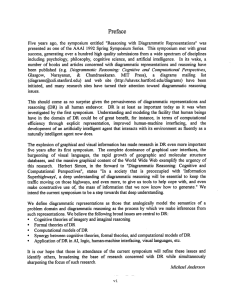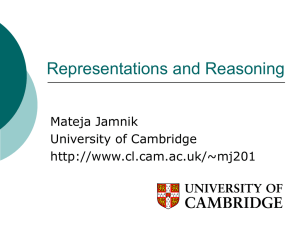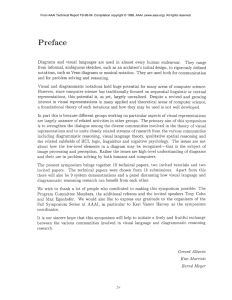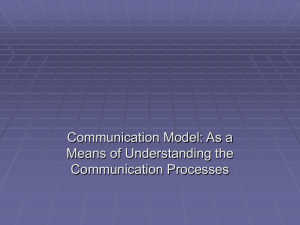A Diagrammatic Reasoning Architecture: Design, Implementation and Experiments
advertisement
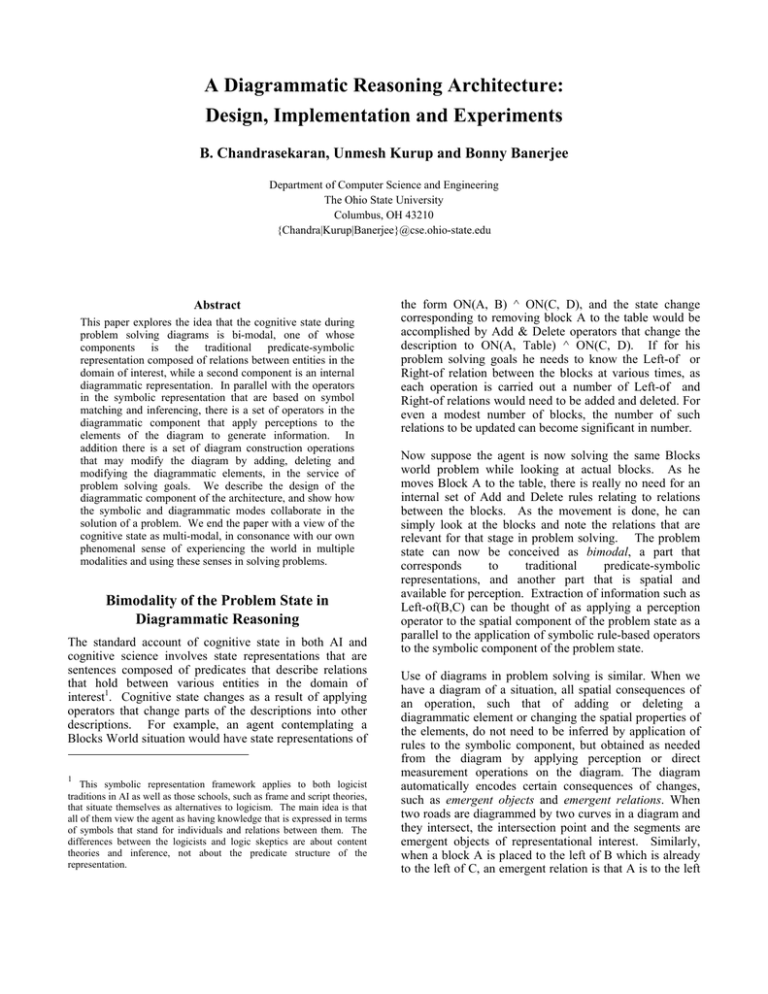
A Diagrammatic Reasoning Architecture:
Design, Implementation and Experiments
B. Chandrasekaran, Unmesh Kurup and Bonny Banerjee
Department of Computer Science and Engineering
The Ohio State University
Columbus, OH 43210
{Chandra|Kurup|Banerjee}@cse.ohio-state.edu
Abstract
This paper explores the idea that the cognitive state during
problem solving diagrams is bi-modal, one of whose
components is the traditional predicate-symbolic
representation composed of relations between entities in the
domain of interest, while a second component is an internal
diagrammatic representation. In parallel with the operators
in the symbolic representation that are based on symbol
matching and inferencing, there is a set of operators in the
diagrammatic component that apply perceptions to the
elements of the diagram to generate information. In
addition there is a set of diagram construction operations
that may modify the diagram by adding, deleting and
modifying the diagrammatic elements, in the service of
problem solving goals. We describe the design of the
diagrammatic component of the architecture, and show how
the symbolic and diagrammatic modes collaborate in the
solution of a problem. We end the paper with a view of the
cognitive state as multi-modal, in consonance with our own
phenomenal sense of experiencing the world in multiple
modalities and using these senses in solving problems.
Bimodality of the Problem State in
Diagrammatic Reasoning
The standard account of cognitive state in both AI and
cognitive science involves state representations that are
sentences composed of predicates that describe relations
that hold between various entities in the domain of
interest1. Cognitive state changes as a result of applying
operators that change parts of the descriptions into other
descriptions. For example, an agent contemplating a
Blocks World situation would have state representations of
1
This symbolic representation framework applies to both logicist
traditions in AI as well as those schools, such as frame and script theories,
that situate themselves as alternatives to logicism. The main idea is that
all of them view the agent as having knowledge that is expressed in terms
of symbols that stand for individuals and relations between them. The
differences between the logicists and logic skeptics are about content
theories and inference, not about the predicate structure of the
representation.
the form ON(A, B) ^ ON(C, D), and the state change
corresponding to removing block A to the table would be
accomplished by Add & Delete operators that change the
description to ON(A, Table) ^ ON(C, D). If for his
problem solving goals he needs to know the Left-of or
Right-of relation between the blocks at various times, as
each operation is carried out a number of Left-of and
Right-of relations would need to be added and deleted. For
even a modest number of blocks, the number of such
relations to be updated can become significant in number.
Now suppose the agent is now solving the same Blocks
world problem while looking at actual blocks. As he
moves Block A to the table, there is really no need for an
internal set of Add and Delete rules relating to relations
between the blocks. As the movement is done, he can
simply look at the blocks and note the relations that are
relevant for that stage in problem solving. The problem
state can now be conceived as bimodal, a part that
corresponds
to
traditional
predicate-symbolic
representations, and another part that is spatial and
available for perception. Extraction of information such as
Left-of(B,C) can be thought of as applying a perception
operator to the spatial component of the problem state as a
parallel to the application of symbolic rule-based operators
to the symbolic component of the problem state.
Use of diagrams in problem solving is similar. When we
have a diagram of a situation, all spatial consequences of
an operation, such that of adding or deleting a
diagrammatic element or changing the spatial properties of
the elements, do not need to be inferred by application of
rules to the symbolic component, but obtained as needed
from the diagram by applying perception or direct
measurement operations on the diagram. The diagram
automatically encodes certain consequences of changes,
such as emergent objects and emergent relations. When
two roads are diagrammed by two curves in a diagram and
they intersect, the intersection point and the segments are
emergent objects of representational interest. Similarly,
when a block A is placed to the left of B which is already
to the left of C, an emergent relation is that A is to the left
of C. Perception picking up the spatial consequences of
changes has been called a free ride (Shimojima, 1996) and
is one of most important advantages of a diagrammatic
representation.
Diagrams do not have to be external. In a good deal of
human problem solving people experience mental images
similar to a diagram. Of course internal diagrams are
subject to short term memory limitations, but
phenomenologically, problem solving has a character
similar to that when external diagrams are involved. That
is, they apply what they experience as internal perception
and extract some information that they may combine with
linguistically couched information to make further
inferences. In these cases, the problem state is completely
internal and bimodal.
We have been developing an architecture for diagrammatic
reasoning that is intended to support problem solving with
such bimodal problem states. The linguistic/symbolic
mode supports knowledge representations and inferences
that are traditional in AI, while the diagrammatic mode
supports a representation that captures the spatial aspects
of the configuration of objects in a diagram, and an openended set of perceptions that can add information to the
symbolic component of the problem state. By the same
token, there are operators that can modify the diagram in
various ways to capture the effects of intended operations.
Problem solving is goal-driven, as in cognitive
architectures such as Soar. Problem solving proceeds
opportunistically, whichever mode can help in the solution
of a subtask makes the contribution, and the problem state
changes. This process repeats until the problem is solved
(assuming it is solvable given the knowledge). The goal
of this paper is to outline our architecture, detail some
aspects of the diagrammatic representation, and give an
example of its use.
The Architecture
External
Diagram
Action
Routines
Problem
Solver
Perceptual
Routines
Inference
Rules
DRS
Symbolic
Information
DRS (for diagrammatic representation system) is the
internal representation of the diagram, thus providing the
diagrammatic part of the bimodal problem state. DRS can
be the result of perception on an external image of a
diagram, (constructed by that part of visual perception that
breaks the image array into objects, or manually, as in our
experiments), composed internally from perceptual
memory fragments, or a combination of the two. Thus the
architecture is a functional diagrammatic problem solver
even in the absence of an external diagram. DRS is
intended to correspond to the experience of seeing a
diagram as a configuration of spatial objects. A set of
perceptions can generate information about the diagram.
Action routines construct or modify aspects of the diagram
to satisfy various constraints. The problem solver treats
both the diagrammatic and the symbolic components as
parallel representations and potentially equal sources of
progress towards the goal.
Diagrammatic Representation
Three Dimensions of Perceptual Experience. We view
the experience corresponding to visually perceiving a
scene as having three aspects or stages. The first and most
basic dimension is that of seeing the world as composed of
objects – the figure, a set of objects, is discriminated from
ground. With diagrams, this dimension corresponds to
perceiving it as composed of objects – or figures – as 2-d
shapes. The second dimension is that of seeing as, e.g.,
recognizing an object as a telephone, or a figure in a
diagram as a triangle. The recognition vocabulary comes
in a spectrum of domain-specificity. The third dimension is
relational – seeing that an object is to the left of another
object, taller than another, is part of another, etc. The
result of these latter two dimensions of perception is not
the spatiality of the objects as such, but symbols and
symbol structures that assert and describe, albeit in a
vocabulary using spatial terms.
DRS
DRS is intended to capture the result of the figure-ground
separation and seeing the diagram as composed of
diagrammatic objects with spatial extent. In our current
work we consider diagrams that are “black and white” (i.e.,
no grey scale carrying domain information), though the
framework can be extended to account for additional types
of diagrams. While objects in an external diagram of this
type always appear as regions, they are intended as
configurations of three kinds of objects, point, curve and
region. For example, a city in the US map might appear as
a small circle, but the reader takes it as a point; the
diameter of the circle might symbolize a label for the size,
but it is not intended to be proportional to the area of the
city. DRS is a representation of the abstract diagram
intended.
Again, a physical diagram may have
alphanumeric labels to be seen as attached to objects, and
they may also have pictorial iconic aspects, such as a
picture of a church at its location to signal the type of
building. DRS does not contain the spatial information
corresponding to these various symbols, but uses this
information as symbols attached to the objects. Just as a
symbol in a symbolic representation in an external medium
is a pointer to an abstract symbol in the agent, a diagram
on a piece of paper is a pointer to a more abstract diagram
of the sort that is in DRS.
DRS is generic. Information that is domain-specific, e.g.,
that a certain curve is a defensive perimeter, is simply
treated as abstract symbolic information, and incorporated
as labels attached to the objects to be interpreted by the
problem solver using domain-specific conventions. At the
level of DRS, there is no recognition of a curve as a
straight line, or a region as a polygon. These are
recognitions that will be made further downstream by
perceptual routines. Also, how curves and regions are
actually represented in a computational realization is not
relevant at the level of DRS. For example, in a specific
implementation, a curve may in fact be represented as a
sequence of line segments (as we do in our
implementation), or as a set of pixels in an array-based
representation. These are representational details below
the level of the abstraction of DRS, in which such an
object is still a curve.
Perceptual Routines
Perceptual routines in our architecture operate on the
objects in DRS and produce two kinds of information.
One is reperceiving the diagram to identify emergent or
lost objects (points, curves and regions) as objects are
added, deleted or modified. The second is that object
properties and inter-object relations of specific kinds
between objects (such as object A is inside object B) are
computed in response to problem solving goals. A brief
list of routines that are currently available is given below.
Emergent Object Recognition Routines. Intersection-points
between curve objects, region when a curve closes on
itself, new regions when regions intersect, new regions
when a curve intersects with a region, extracting
distinguished points on a curve (such as end points) or in a
region, extracting distinguished segments of a curve (such
as those created when two curves intersect), extracting
periphery of a region as a closed curve. Removal of objects
that no longer exist when something changes are included.
Object Property Extraction Routines. Examples: Lengthof(curve) (this will return a number), Straightline(Curve)
and Closed(Curve) will return True or False.
Relational Perception Routines. Examples: Inside (I1,I2),
Outside, Left-of, Right-of, Top-of, Below, Segment-of
(Curve1, Curve2), Subregion-of (Region1, Region2), On
(Point,Curve), and Touches(object1, object2), Anglevalue(curve AB, curve BC). Subsumption relations are
especially important and useful to keep track of as object
emerge or vanish.
Abstractions of groups of objects into higher level objects.
Domain-specificity. Perceptions may be domain-specific
because they are of interest only in some domains, e.g., “an
L-shaped region.” They may also be domain-specific in
that they combine pure spatial perception with domainspecific, but nonspatial, knowledge. For example, in a
military application, a curve representing the motion of a
unit towards a region might be interpreted as an attack, but
that interpretation involves combining domain-independent
spatial perceptions – such as extending the line of motion
and noting that it intersects with the region – with nonspatial domain knowledge – such as that the curve
represents the motion of a military unit, that the region’s
identity is as a military target belonging to a side that is the
enemy of the unit that is moving, etc. In our current
implementation, it is the task of the problem solver to
combine
appropriately
the
domain-independent
perceptions with domain-specific knowledge to arrive at
such
conclusions,
but
in
application-dependent
implementations of the architecture, some of these
perceptions might be added to the set of perceptual
routines.
Action Routines
The problem solving process may modify the diagram –
create, destroy or modify objects. Typically, the task – the
reverse of perception in some sense – involves creating the
diagram such that the shapes of the objects in it satisfy a
symbolically stated constraint, such as “add a curve from
A to B that goes midway between regions R1 and R2,” and
“modify the object O1 such that point P in it touches point
Q in object O2.” Constructing or modifying diagrammatic
elements that satisfy such constraints involves a set of
Action Routines parallel to Perception Routines. Similar
to PRs, ARs can vary in generality. An AR that we
haven’t yet used, but we think would be especially
valuable, is one that changes a region object into a point
object and vice versa as the resolution level changes in
problem solving, such as a city appearing as a point in a
national map, while it appears as a region in a state map.
Functional Character of the Representation and
the Routines
There is a tendency to assume that diagrammatic reasoning
is defined in terms of some kind of array computing, in
which a 2-D array represents the pixels of the diagram.
However, for us, the essence of diagrammatic reasoning is
its functional character; namely, a diagram is a functional
specification of the spatial information about diagrammatic
objects. The various perceptions and actions are also
functionally defined. How they are represented and the
corresponding algorithms are not of interest at the level of
the diagrammatic reasoning problem solving framework.
The framework focuses on the functional roles and the
mutual interactions of the diagrammatic and symbolic
components. Of course, the computational properties of
the representations and algorithms are of interest at the
computational theory level of Marr or the Symbol level of
Newell (Newell, 1990), but it is important to keep the
levels distinct so the real commitments of the framework
are properly grasped.
distance T1 and T2 could have traveled given their
maximum speed and times elapsed, and asks the
diagrammatic reasoner to identify possible paths that the
two previous vehicles might have taken to get to the
Experiments in
Diagrammatic Problem Solving
We have applied the architecture to a number of problems
in Army applications: recognition of maneuvers
(Chandrasekaran, 2004), critiquing a proposed route for
vulnerability to certain kinds of attacks, and a problem in
entity reidentification. We describe briefly the lastmentioned experiment to indicate how the architecture
actually works.
Diagrammatic Reasoning for Entity
Reidentification
The problem of entity reidentification arises as a subtask in
defense systems that are intended to identify and keep
track of enemy assets, based on a variety of information
sources, such as satellite photos, human reports, sensor
reports and so on. A typical problem arises as follows. A
report is received of a sighting of a vehicle of a certain
type at a certain location and time. The task is to decide if
the new sighting is the same as any of the entities in its
database of earlier sightings, or an entirely new entity.
Reasoning has to integrate information from different
sources – database of sightings, capabilities of vehicles,
sensor reports, terrain and map information – to make the
decision. Our experiment uses a generic fusion engine2 for
generating, evaluating, combining, and modifying
hypotheses about the entity. Diagrammatic reasoning is
used to handle spatial aspects: Possible routes, whether
routes intersect sensor fields, and how to modify routes to
avoid sensor fields.
We will refer to the main problem solver as the Fusion
Engine or FE in the rest of the discussion.
In the first figure, the terrain map is shown along with
three mountainous regions that are drawn to indicate that
they are no-go areas for the vehicle types of interest. (The
regions are manually drawn, corresponding to a pre-drawn
diagram.) The newly sighted vehicle is the small circle at
the bottom right. The FE asks the database for previously
sighted vehicles of the same type as the newly sighted one,
along with the times and locations. The database has
responded with two vehicles that are indicated in the
diagram below as two small circles, one at the top and the
other at bottom left. Let us call them T1 and T2 (with the
new vehicle denoted by T3).
The DRS at the point consists of the three region objects
and three point objects. The FE determines the maximum
2
The fusion engine and the problem solving strategy are due to our
colleagues John Josephson and Vivek Bharathan.
location of the newly sighted vehicle. The diagrammatic
reasoner’s Action Routine comes up with two possible
paths for each of the vehicles, along with their lengths.
The figures below show the routes that each of the vehicles
could have taken. The FE discards the longer of the two
routes for each of the vehicles as being too long for the
time available.
The FE now asks the sensor database for information about
sensor fields in the area of interest, including their
locations and if they reported any vehicle crossings during
the period of interest. It gets back information about the
locations of two sensor fields that exist in the region, and
that neither of them reported any vehicle crossings. FE
asks the diagrammatic engine if the routes for each of the
vehicles cross either of the sensor fields. The next figure
shows the situation. The diagram has been updated with
two sensor fields (represented by two small region objects,
one at the top and the other closer to the bottom), and we
can see that each of the routes indeed crosses one of the
sensor fields. The diagrammatic reasoner’s perception
system extracts the same information and passes it on to
the FE.
The routes are not exact paths, but representative members
of a class of routes, all of which have the property that they
pass between two no-go regions and do not exceed the
length constraint. FE now checks if the vehicles routes
could have avoided the sensor fields so that the nonreporting by sensor fields could be explained. So it asks
the diagrammatic component if the routes could be
modified so as to avoid the regions corresponding to
sensor fields. The diagrammatic reasoner concludes that
the route for T1 could not be modified, but constructs a
modified route for T2 as shown in the next figure.
FE now concludes that the most plausible hypothesis is
that the newly sighted vehicle is T2 taking the lower route
but avoiding the lower sensor field.
The figures that are shown in this discussion are from the
display that is updated during the reasoning. The diagrams
on the display are generated and updated from the DRS
within the diagrammatic reasoning system. All the
constructions of diagrammatic elements (such as routes)
and perceptions (such as that a route intersects a sensor
region) are all computed by the diagrammatic reasoner
using DRS and a variety of action and perception routines.
The display itself does not play a role in the reasoning,
except when a user introduces new diagrammatic objects,
which are then used to update DRS.
Related Work
This work is an evolution of earlier general proposals
made in (Chandrasekaran, 1997). The following is a
sampling of work in diagrammatic research on mixing the
symbolic and perceptual modes. Geometry theorem
proving has especially been a task that has seen much
research in this area, with (Lindsay, 1998) and (Koedinger,
1995) being well-known recent examples. Diagrammatic
and symbolic representations in device behavior
understanding are considered in (Narayanan, 1995). While
there are many points of contact between the
representation of the diagram in these systems and DRS,
our overall goal is a generic architecture for bimodal
problem solving in contrast to the above research whose
proposals for primitive objects and perceptions are tailored
to the needs of their domains. In contrast, we have little to
say about the specific ways in which diagrams work in
their domains, but our more general representations may
be specialized to their needs. (Ferguson, 2000) describes a
program that recognizes domain-specific objects (such as
tea kettles) from diagrams composed of straight line
segments, and extracts spatial relations between the
objects, but does not deal with problem solving in general.
Pineda (Pineda, 1989) treats diagrams as sentences
constructed from diagrammatic primitives and focuses on
the semantics of such sentences. In an informal sense, DRS
is such a sentence, with the semantics of the symbols for
diagrammatic objects being directly represented by its spatial
specification. Heterogeneous representations from a logic
perspective are considered in (Barwise, 1995), and in
database retrieval in (Anderson, 2002), neither of which is
concerned with general issues in problem state
representation. In work on general cognitive architectures
such as ACT-R (Anderson, 1998) and Soar (Newell,
1990), there has been significant recent emphasis on
systems that deal with perceptual input, but the degree of
integration of perception that we are proposing has not
been attempted in those research areas.
The term
“perceptual routines” is related to “visual routines” of
(Ullman, 1984). We use the former term since our longterm interest in extending the framework to other modes of
perception.
It is worth mentioning that the general approach proposed
here is here has points of commonality with the proposal in
(Barsalou, 1999) on perceptual symbol systems. The
elements of the DRS in our architecture are visual symbols
and DRS itself is a visual symbol structure in his sense of
the terms.
Discussion
Our interest in diagrammatic reasoning is at least partly as
a window into cognitive architecture. Our long term goal
is to extend the current architectures that focus exclusively
on the discrete symbolic component and the corresponding
sentential representations to multi-modal states where
perceptual and kinesthetic modes have equal status in the
production of intelligent behavior. Diagrams provide a
nice intermediate point to work – they are practically
important in view of their ubiquity in human problem
solving activity, and raise the basic issues that a general
multi-modal theory of cognitive state will face.
Specifically, the issues have to do with how the various
modes are represented to retain the essential properties of
their mode, and how the multiple modes interact with each
other in solving problems. Our proposal for diagrams says
that internal representations are already partly interpreted
as modal objects, such as points, curves and regions in DR
and similar such objects in other domains. This is in
contrast to the actual external diagram that is an array of
uninterpreted light intensities. We show how in a goaldirected manner the symbolic and diagrammatic
components interact with each other: internal perceptual
routines may supply relational information in symbolic
form to the symbolic component, and the symbolic
component may cause the creation and modification of the
diagrammatic component.
A richer theory of cognitive state with components from
multiple modes can help in a number of ways. It provides
at least a partial relief from the computational burden of
the Frame Problem. Partly, it is just a matter of using the
external world as a constraint enforcer, so that instead of
inferring all the consequences of actions, one may just
look at the external world, or a perceptually accessible
representation of it, and pick up the information. Also,
memory is multi-modal as well. Instead of processing all
the perceptual components of experience for sentences that
may be extracted from it – which are typically too
numerous – storing the experience in some perceptual form
and applying internal perception as and when needed can
be computationally more effective. The diagrammatic
reasoning framework shows how that might work in
general.
As a technology, the DRS/perceptual routines/action
routines component can work with a variety of symbolic
problem solving systems. The routines are extensible and
DRS is generic. We have experimented with the usability
of the technology by trying to apply it to a variety of
problems in Army applications. In (Chandrasekaran,
2004), we reported on the use of the technology for
maneuver recognition. Recently, we were able to build
simple demonstration systems for critiquing courses of
actions with respect to vulnerabilities for attack.
Acknowledgments
This paper was prepared through participation in the
Advanced
Decision
Architectures
Collaborative
Technology Alliance sponsored by the U.S. Army
Research Laboratory under Cooperative Agreement
DAAD19-01-2-0009. Over the years, we have benefited
significantly from collaborations and discussions with John
Josephson, Robert Winkler, Greg Turner, and Vivek
Bharathan.
References
Anderson, M. and B. Andersen, 2002. Heterogeneous Data
Querying in a Diagrammatic Information System, in
Diagrammatic Representation and Inference, M. Hegarty, B.
Meyer, and N.H. Narayanan, Editors. Springer: New York. p.
109-111.
Anderson, J.R. and C.J. Lebiere, 1996, The Atomic Components
of Thought. 1998: Lawrence Erlbaum AssociatesBarwise, J. and
J. Etchemendy, Heterogeneous Logic, in Logical Reasoning with
Diagrams, G. Allwein and J. Barwise, Editors. Oxford University
Press: New York. p. 179-200.
Barsalou, L. W., 1999. "Perceptual symbol systems." Behavioral
and Brain Sciences 22: 577-660.
Chandrasekaran, B. 1997. Diagrammatic Representation and
Reasoning: Some Distinctions. In AAAI Fall 97 Symposium
Series, Diagrammatic Reasoning. Boston, MA: American
Association for Artificial Intelligence.
Chandrasekaran, B, Unmesh Kurup, Bonny Banerjee, John R.
Josephson and Robert Winkler. 2004. An Architecture for
Problem Solving with Diagrams, in Diagrammatic Reasoning and
Inference, Alan Blackwell,
Kim Marriott and Atsushi
Shomojima, Editors, Lecture Notes in Artificial Intelligence
2980, Berlin: Springer-Verlag, 2004, pp. 151-165.
Ferguson, R.W. and K.D. Forbus. 2000. GeoRep: A flexible tool
for spatial representation of line drawings. In Proc. 18th National
Conference on Artificial Intelligence. Austin, Texas: AAAI Press,
pp. 510-516.
Koedinger, K.R. and J.R. Anderson, 1990. Abstract Planning and
Perceptual Chunks: Elements of expertise in geometry. Cognitive
Science, 14: p. 511-550.
Lindsay, R., Imagery and Inference 1995. In Diagrammatic
Reasoning: Cognitive and Computational Perspectives, J.
Glasgow, N.H. Narayanan, and B. Chandrasekaran, Editors.,
AAAI Press/MIT Press: Menlo Park, CA. p. 111-136.
Narayanan, N.H., M. Suwa, and H. Motoda, 1995. Hypothesizing
behaviors from device diagrams, in Diagrammatic Reasoning:
Cognitive and Computational Perspectives, N. Glasgow, N. H.
Narayanan, and B. Chandrasekaran, Editors. The MIT Press:
Cambridge, MA. p. 501-534.
Newell, A., 1990. Unified Theories of Cognition. Cambridge,
MA: Harvard University Press.
Pineda, L., 1989. Graflog: a Theory of Semantics for Graphics
with Applications to Human-Computer Interaction and CAD
Systems, Ph. D. Thesis, University of Edinburgh: Edinburgh,
UK. p. 197+vii.
Shimojima, A., 1996. Operational Constraints in
Diagrammatic Reasoning, in Logical Reasoning with
Diagrams, G. Allwein and J. Barwise, Editors, Oxford
University Press: New York. p. 27-48.
Ullman, S., 1984. Visual routines. Cognition, 18: p. 97-159.
